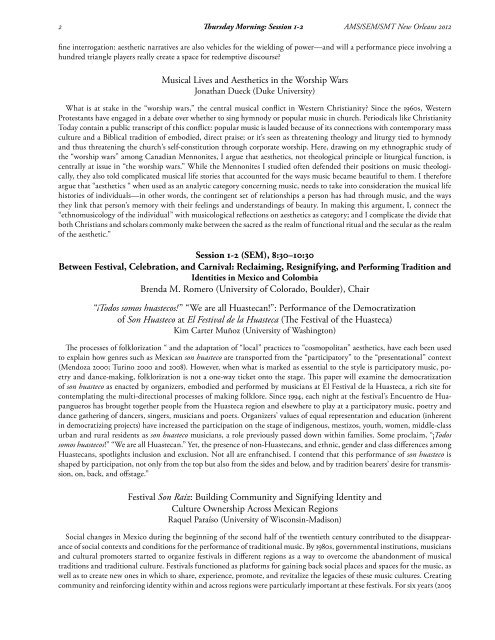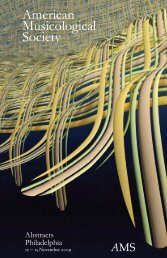Abstracts - American Musicological Society
Abstracts - American Musicological Society
Abstracts - American Musicological Society
You also want an ePaper? Increase the reach of your titles
YUMPU automatically turns print PDFs into web optimized ePapers that Google loves.
2 Thursday Morning: Session 1- 2<br />
AMS/SEM/SMT New Orleans 2012<br />
fine interrogation: aesthetic narratives are also vehicles for the wielding of power—and will a performance piece involving a<br />
hundred triangle players really create a space for redemptive discourse?<br />
Musical Lives and Aesthetics in the Worship Wars<br />
Jonathan Dueck (Duke University)<br />
What is at stake in the “worship wars,” the central musical conflict in Western Christianity? Since the 1960s, Western<br />
Protestants have engaged in a debate over whether to sing hymnody or popular music in church. Periodicals like Christianity<br />
Today contain a public transcript of this conflict: popular music is lauded because of its connections with contemporary mass<br />
culture and a Biblical tradition of embodied, direct praise; or it’s seen as threatening theology and liturgy tied to hymnody<br />
and thus threatening the church’s self-constitution through corporate worship. Here, drawing on my ethnographic study of<br />
the “worship wars” among Canadian Mennonites, I argue that aesthetics, not theological principle or liturgical function, is<br />
centrally at issue in “the worship wars.” While the Mennonites I studied often defended their positions on music theologically,<br />
they also told complicated musical life stories that accounted for the ways music became beautiful to them. I therefore<br />
argue that “aesthetics “ when used as an analytic category concerning music, needs to take into consideration the musical life<br />
histories of individuals—in other words, the contingent set of relationships a person has had through music, and the ways<br />
they link that person’s memory with their feelings and understandings of beauty. In making this argument, I, connect the<br />
“ethnomusicology of the individual” with musicological reflections on aesthetics as category; and I complicate the divide that<br />
both Christians and scholars commonly make between the sacred as the realm of functional ritual and the secular as the realm<br />
of the aesthetic.”<br />
Session 1-2 (SEM), 8:30–10:30<br />
Between Festival, Celebration, and Carnival: Reclaiming, Resignifying, and Performing Tradition and<br />
Identities in Mexico and Colombia<br />
Brenda M. Romero (University of Colorado, Boulder), Chair<br />
“ ¡ Todos somos huastecos! ” “We are all Huastecan!”: Performance of the Democratization<br />
of Son Huasteco at El Festival de la Huasteca (The Festival of the Huasteca)<br />
Kim Carter Muñoz (University of Washington)<br />
The processes of folklorization “ and the adaptation of “local” practices to “cosmopolitan” aesthetics, have each been used<br />
to explain how genres such as Mexican son huasteco are transported from the “participatory” to the “presentational” context<br />
(Mendoza 2000; Turino 2000 and 2008). However, when what is marked as essential to the style is participatory music, poetry<br />
and dance-making, folklorization is not a one-way ticket onto the stage. This paper will examine the democratization<br />
of son huasteco as enacted by organizers, embodied and performed by musicians at El Festival de la Huasteca, a rich site for<br />
contemplating the multi-directional processes of making folklore. Since 1994, each night at the festival’s Encuentro de Huapangueros<br />
has brought together people from the Huasteca region and elsewhere to play at a participatory music, poetry and<br />
dance gathering of dancers, singers, musicians and poets. Organizers’ values of equal representation and education (inherent<br />
in democratizing projects) have increased the participation on the stage of indigenous, mestizos, youth, women, middle-class<br />
urban and rural residents as son huasteco musicians, a role previously passed down within families. Some proclaim, “¡Todos<br />
somos huastecos!” “We are all Huastecan.” Yet, the presence of non-Huastecans, and ethnic, gender and class differences among<br />
Huastecans, spotlights inclusion and exclusion. Not all are enfranchised. I contend that this performance of son huasteco is<br />
shaped by participation, not only from the top but also from the sides and below, and by tradition bearers’ desire for transmission,<br />
on, back, and offstage.”<br />
Festival Son Raíz: Building Community and Signifying Identity and<br />
Culture Ownership Across Mexican Regions<br />
Raquel Paraíso (University of Wisconsin-Madison)<br />
Social changes in Mexico during the beginning of the second half of the twentieth century contributed to the disappearance<br />
of social contexts and conditions for the performance of traditional music. By 1980s, governmental institutions, musicians<br />
and cultural promoters started to organize festivals in different regions as a way to overcome the abandonment of musical<br />
traditions and traditional culture. Festivals functioned as platforms for gaining back social places and spaces for the music, as<br />
well as to create new ones in which to share, experience, promote, and revitalize the legacies of these music cultures. Creating<br />
community and reinforcing identity within and across regions were particularly important at these festivals. For six years (2005










